Medically review by Kim Langdon
Quinoa - pronounced keen-wah - is a pseudo-grain and superfood that has been growing exponentially in popularity amongst plant-based eaters, gluten-free eaters, and adventurous eaters alike.
While it looks, feels, and cooks a lot like a grain, quinoa is actually a seed which is why it is described as a pseudo-grain or pseudocereal - sort of like buckwheat.
Quinoa is naturally gluten-free which makes it safe for most folks to eat.
Even people who follow a modified paleo diet include quinoa sometimes as a source of protein.
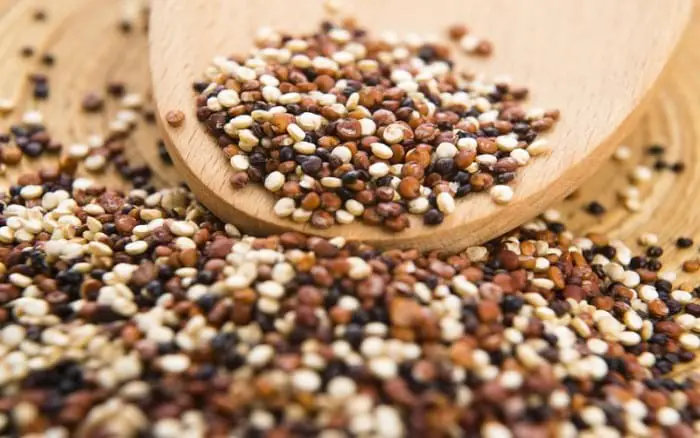
Speaking of protein, quinoa is considered a complete plant protein.
Basically, our bodies use 20 different amino acids to form proteins in the body, and for a food to constitute a complete protein, it must contain the 9 amino acids that our bodies can't synthesis without a food source.
Many complete proteins happen to be animal foods, but there are a few miraculous and powerful plant sources out there too.
Quinoa comes from the same plant family as amaranth, another popular pseudo-cereal grain.
This 7,000-year-old plant originated in the Andes of South America, but humans have only been harvesting quinoa and using it as a source of nutrition for 3-4,000 years.
It's still a pretty long time - long enough for us to get curious about this health food, its history, and its benefits!
Quinoa's nutritional profile
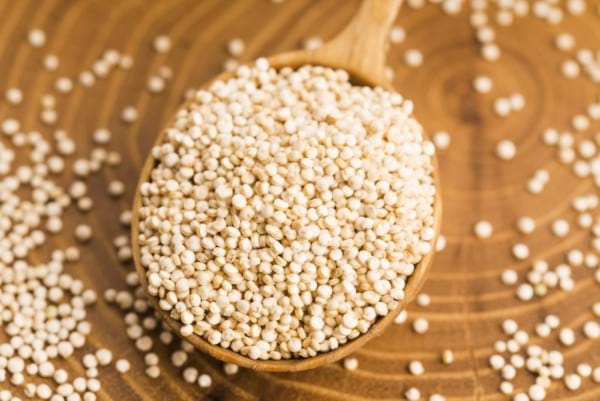
Before we get into some of the more intricate details of why quinoa is such a healthy choice, let's talk about its nutritional profile.
We'll check out the macronutrients and micronutrients which will help you to see why some of those benefits exist.
Per one cup of cooked quinoa, here is what you get.
- Calories: 222 calories
- Fat: 3.6 grams
- Protein: 8.1 grams
- Carbohydrates: 39.4 grams
- Fiber: 5.2 grams
- Calcium: 31.5 mg (3% DV)
- Iron: 2.8 mg (15% DV)
- Magnesium: 115 mg (30% DV)
- Phosphorous: 281 mg (28% DV)
- Potassium: 318 mg (9% DV)
- Manganese: 1.2 mg (58% DV)
- Selenium: 5.2 mcg (7% DV)
- Thiamin: 0.2 mg (13% DV)
- Riboflavin: 0.2 mg (12% DV)
- Niacin: 0.8 mg (4% DV)
- Folate: 77.7 mcg (19% DV)
- Vitamin B6: 0.2 mg (11% DV)
While quinoa is mostly rich with fiber, protein, and B vitamins, it also contains some vitamin E and vitamin A.
Overall, it is an incredible source of minerals and energizing vitamins.
Finally, quinoa contains a really naturally balanced macronutrient ratio with a healthy dose of slow carbs paired with protein and fiber for long-lasting fuel.
The Benefits of Quinoa
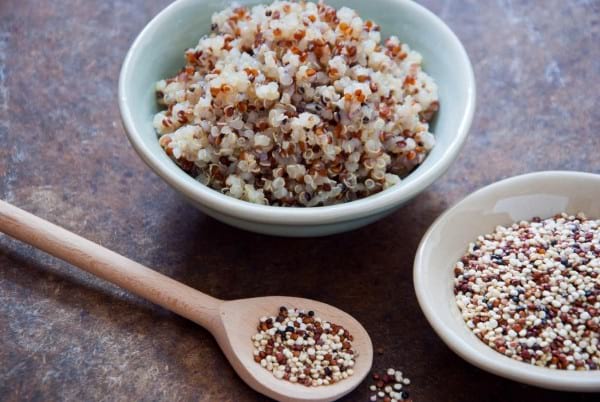
It's a heart-healthy food.
First, quinoa contains a great profile of healthy fats in addition to its high protein content.
It doesn't get quite enough credit for its monounsaturated fat content or oleic acid.
Nor do we talk about the omega-3 fatty acids contained in quinoa or the alpha-linoleic acid. ALA is one of the strongest protectors against heart disease and is known to reduce the risk of cardiac arrest.
We know that ALA intake is much more potent when ingested from food sources in comparison to supplement sources, so adding an ALA-rich food like quinoa to the diet is a great preventative measure.
Moreover, research shows that potassium intake can reduce blood pressure in individuals with hypertension.
A serving of quinoa provides around 10% of the daily recommended value of potassium.
In conjunction with other heart-healthy minerals like magnesium and manganese, this heart-healthy food may prevent stroke and other instances of heart disease.
In fact, the same research concludes that increased potassium intake could reduce the risk of stroke by up to 24% - pretty significant!
It's great for digestion.
Considering quinoa has a pretty high fiber content, we know it's great for digestion.
Getting enough fiber can make a massive difference in digestion in terms of keeping you regular, avoiding constipation, and reducing gas/bloating.
Fibrous foods tend to make us feel more full. They add bulk to our food and slow down the digestion of carbohydrates, making that energy more long-lasting.
Fibre also absorbs moisture in the gut, adds bulk to the stool as well, and helps to move things along.
Adding fiber to the diet can be a simple cure to constipation.
A cup of cooked quinoa provides nearly a quarter of the daily recommended value.
While quinoa isn't easy for everyone to digest (which we will talk about later), it can make all the difference for some.
Another factor to consider is the high content of manganese found in quinoa.
Manganese plays a role in the production of digestive enzymes - compounds that break down difficult-to-digest proteins - and makes it easier for the body to digest food overall.
A cup of cooked quinoa provides more than half of the daily recommended value of manganese.
It can help you to lose weight.
We all want to know what we should eat to lose weight, right?
The best foods for weight loss are ones that give you the most bang for your buck, and that's one of the main reasons we adore quinoa.
It truly hits all the notes, and it's a must-have pantry staple while working towards fat loss goals.
First of all, fiber and protein together make for the most dynamic duo when tailoring your diet to your weight loss goals.
Calorie restriction is necessary, but sticking to those calorie goals can be really tough!
Eating the right foods makes all the difference.
A food that is both rich with protein and fiber is filling and will keep you fuller and energized for longer during the day.
Moreover, this will help you fight cravings and avoid overeating.
This study shows that alternative grains to wheat such as barley, oats, and quinoa ranked higher in overall satisfaction and satiety, proving this "grain" to be superior in weight loss diets.
It has anti-inflammatory properties.
Inflammation management can be crucial for people with autoimmune disease to see remission, and for preventing disease overall.
Inflammation is a normal response within the body to pain or a stressor, but sometimes, our bodies get a little haywire.
This is when inflammation becomes a problem - when it persists. Eating a diet chock full of anti-inflammatory foods and ingredients can help.
Most real food diets will meet those needs effortlessly, and quinoa is a part of that protocol.
The outer shell of quinoa contains phytochemicals called saponins which, according to this research, can inhibit inflammatory cytokines from releasing.
However, those same saponins can cause intestinal distress!
Fortunately, the antioxidant content of quinoa is also anti-inflammatory.
This study looks at the polyphenols found in quinoa and concludes that they can prevent inflammation in the intestines - particularly in obese subjects.
It's naturally gluten-free.
While the whole gluten-free thing might seem like a trend that appeared out of nowhere, it's not just coeliacs who suffer from eating gluten!
Gluten intolerance and gluten sensitivity are legitimate health concerns, and more and more people are recognizing that wheat just doesn't work for them.
Quinoa is naturally non-allergenic, wheat-free, and gluten-free.
Like we mentioned above, it's not even a grain. Technically and botanically, quinoa is a seed.
While individuals with compromised gut health should take more precaution when eating seeds and/or grains (which we'll discuss in the section below), most people won't react poorly to eating quinoa occasionally.
This makes it a great alternative to other grains or wheat products people may be avoiding.
Hey - we have to find some way to get our fix!
It can help manage cholesterol numbers.
Cholesterol is a fine balance between HDL and LDL numbers. Fibre, in particular, is known to manage cholesterol levels well.
Research shows that amaranth protein (the same family crop quinoa is derived from) has a positive effect on cholesterol metabolism, and animals in the study saw a reduction in total plasma cholesterol concentration.
It's an anti-cancer food.
Many foods are anti-cancer because they feed our cells and ward off oxidative damage with their high antioxidant content.
If we break it down, we can see that quinoa contains many compounds that are crucial for our bodies to fight disease as effectively and efficiently as possible.
Let's dissect this a little further.
This study - which looks closer at quinoa leaves - shows that they contain chemopreventive and anti-carcinogenic properties, with both high bioavailability and bioaccessibility meaning that this source is particularly usable by our bodies.
Ultimately, we can trace these properties back to antioxidant content.
However, there are a few Saponins - the "evil" sort of anti-nutrient - actually come in the clutch again here; this research shows that they have chemotherapeutic potential.
Moreover, we can see peptide lunasin has the potential to selectively kill cells, meaning there is potential for killing cancer cells without impacting healthy cells, according to this study.
Lastly, antioxidant quercetin is a powerful fighter of free radical damage, also addressing cancer potential at the cellular level.
This study shows that it is particularly effective in the prevention of lung cancer.
It's friendly for the gut (the second brain).
You might know about the gut-brain axis, and why we refer to the gut as the second brain.
It controls almost our entire immune system, and the more we learn, the more we uncover.
There are links between the gut and digestion, mental health, and just about everything you can imagine.
Feeding our gut the right foods is imperative if you're chasing after fabulous, sustainable health.
Since quinoa is an anti-inflammatory food and we know that its antioxidant content can address intestinal inflammation, it automatically gets two thumbs up from our guts!
One of the most convincing factors is that quinoa contains something called butyrate which is a fatty acid that our guts thrive on.
When we don't get enough from food sources, our gut health becomes compromised.
Furthermore, quinoa contains prebiotics which help to fuel and feed probiotics, maintaining healthy gut flora.
It may help prevent type 2 diabetes.
Preventing type 2 diabetes is a balance of managing and maintaining a healthy weight while also eating to manage your blood sugar.
Insulin resistance and metabolic disease often accompany obesity, but poor blood sugar control can affect anyone!
A diet of processed food drives the blood sugar spikes and drops for people at any weight, so eating foods that help keep that balance in check is a great way to ward off diabetes.
Quinoa is a great food for pre-diabetic individuals to add to their diet, especially those attempting to cut out refined grains and sugars.
This research done on mice shows promising results. The leaching of quinoa significantly reduced fasting blood glucose in obese, hyperglycemic subjects.
This is because the leaching process can utilize the concentrated bioactive phytochemicals found in quinoa.
Another study showed that more than half of the participants who consumed quinoa cereal bars for 30 days saw a reduction in blood glucose levels.
Additional research shows that high amounts of manganese - found in quinoa - may improve glucose tolerance by increasing the secretion of insulin.
It contains essential minerals for good bone health.
Manganese is a pretty powerful mineral. It's one of the main reasons why quinoa is so good for bone health and bone strength.
Many folks who avoid dairy want to know if that puts them at risk for osteoporosis.
Fortunately, there are other ways to fill in those nutritional gaps and keep the bones strong, in addition to regular strength training and/or yoga.
Magnesium and phosphorous found in quinoa also make it a great food for bone health.
In most cases, it is much more effective to see benefits from minerals and vitamins when you primarily consume them in food form versus a supplement.
How to prepare quinoa
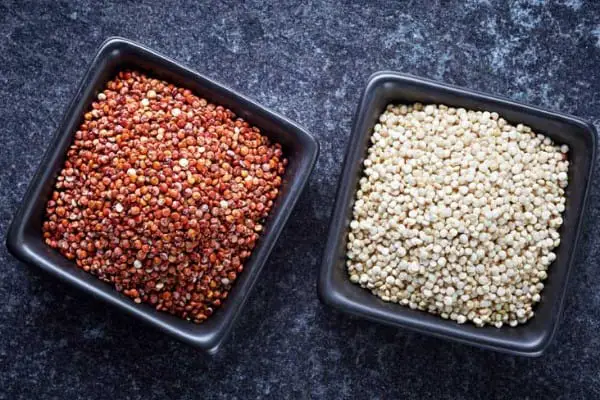
Quinoa is very healthy food and it works for most folks, especially because it's naturally gluten-free.
However, all grains and seeds contain something called anti-nutrients.
For example, the saponins we mentioned above for all of their numerous benefits can actually bind to vitamins and minerals, making them less available for the body to use.
When consuming grains, nuts, seeds, and legumes, it's important to know how we can optimize the experience and ensure the nutrients in that food and the foods we pair it with are bioavailable.
First, it's important to rinse quinoa. Those saponins will come right off with a rinse, and you'll notice.
They have a slight tendency to almost lather like soap, and you'll know that your quinoa is "clean" when the bubbles stop forming.
This process will also help reduce the bitter taste that saponins produce, and help you to avoid any digestive distress quinoa might cause.
Simply run cold water over quinoa in a fine-mesh strainer, and rub between your hands while doing so.
Alternatively, you can soak quinoa.
An overnight soak followed up with a rinse will give you the best results and reduce the anti-nutrient content of this pseudo-cereal the most effectively.
This is the best course of action for someone with compromised gut health/permeability, autoimmune disease, or for reintroduction phases following up a strict reset phase (e.g paleo, autoimmune protocol, Wahl's, etc.).
10 Healthy Quinoa Recipes
If you're curious about quinoa and ready to introduce this little superfood into your diet more often, these recipes should inspire you.
All recipes featured are gluten-free and many are suitable for a vegan diet.
Many are also suitable for a modified paleo diet if you're working on introducing foods that were previously eliminated.
Quinoa is less irritable than most traditional grains and can be a really wonderful source of protein for those who want to rely less on meat.
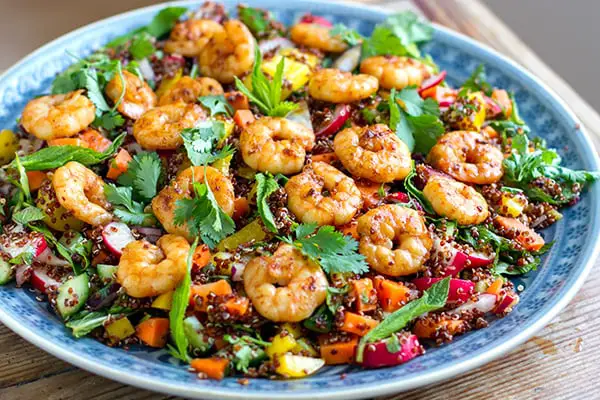
Quinoa makes a really lovely addition to both cold and warm salads, adding some bulk both nutritionally and in texture.
This salad is packed with awesome, slightly spicy Thai flavor.
It's micronutrient-dense with plenty of colorful veggies and greens, plus you get double the protein when you add prawns.
This recipe would also work well with poultry, tofu, or tempeh depending on your preferences and dietary restrictions.
2. Buffalo chickpea quinoa burgers from Connoisseurs Veg
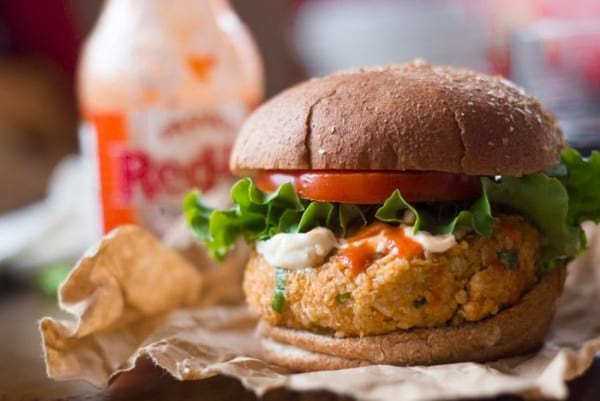
If you want to get your junk food and fast food cravings out of the way with something a bit more wholesome than what you'll get in the drive-thru, these burgers are the jam.
Packed with buffalo flavor from classic Frank's Red Hot sauce, these real food burgers are vegan-friendly, packed with oats, quinoa, and chickpeas for protein, and perfect sandwiched between your favorite buns.
Top however you like your burgers and boom - dinner is served.
3. Mexican chicken quinoa casserole from Well Plated

Casserole is always a winner when it comes to whipping up a tasty dinner in a pinch.
It's a one-pan affair so you don't have to fuss with a bunch of dishes or clean-up.
With Mexican flavor and flair, this casserole is loaded with tender chicken, fluffy quinoa, and black beans for a filling and hearty slice.
These are leftovers you'll love. Make them new again by slicing fresh avocado and chopping fresh cilantro on top!
4. Quinoa dark chocolate breakfast cookies from Platings & Pairings
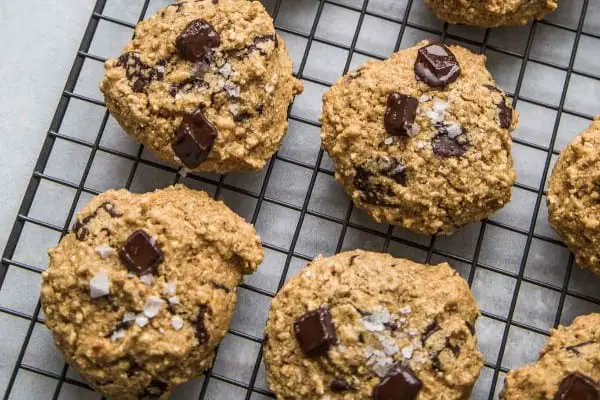
These healthy cookies are totally acceptable to eat for breakfast. How many cookie recipes can you say that about?
These guys are healthy and satiating, making it convenient to pack in some nutrient-dense bites on the go.
Oh, and there will be big, gorgeous, decadent chunks of chocolate chips. Who can complain about that?
A sprinkle of flaky sea salt gives these all the spunk and zest they need. Bonus: the kids will adore these!

While oatmeal is naturally gluten-free, sometimes it's exciting to switch things up.
Even if you are a diehard oatmeal enthusiast and seldom step outside of the box for breakfast, this lovely, rich, and flavorful porridge might change your mind.
You can make it in just five minutes by prepping the quinoa ahead of time.
It makes a lovely morning meal, packed with plant protein and fiber to keep you full and focused until lunch - guaranteed.
6. Garlic mushroom quinoa from Damn Delicious
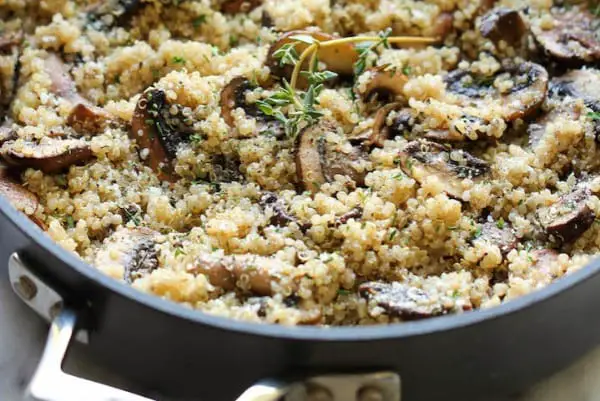
This casserole-like dish is rich with meaty mushrooms, infused with tasty garlic, and Italian spices.
It's just a few humble ingredients which makes this side SO simple to serve!
You can add to it if you'd like too. Fresh greens and cherry tomatoes would work fabulously in this dish.
Keep it vegan or not by sprinkling some Parmesan on top. So worth it.
7. Honey-lime quinoa fruit salad from The Recipe Critic
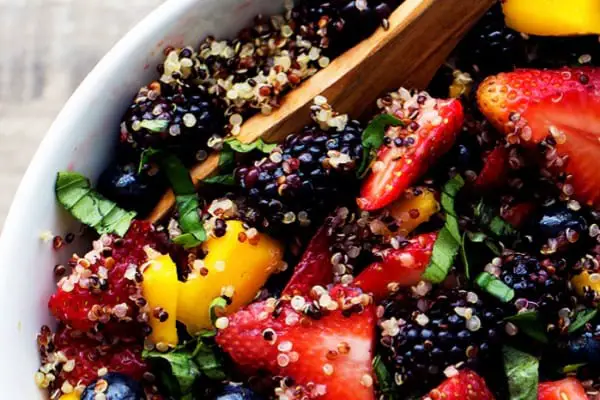
This light and healthy fruit salad is perfect for any season or any occasion.
It makes an easy, nourishing, and colorful snack or a fabulous recipe to whip up when you're going to a potluck.
Quinoa adds some lovely texture and benefits to your favorite fruit salad recipe. Use whatever is in season, and impress your guests with this unique fruit salad recipe.
A squeeze of honey and lime will add plenty of sweetness and zest, too.
8. Sweet potato & black bean quinoa bowls from Spoonful of Flavor
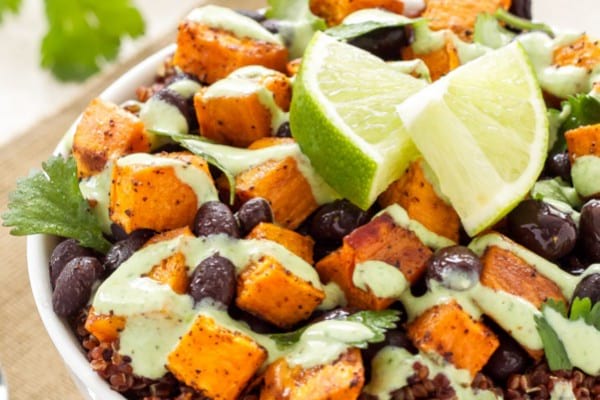
This power bowl makes a fantastic lunch to take to the office or make ahead of time.
With three superfood ingredients to make up the bulk of this, you'll find unbeatable texture, flavor, and satiation in this bowl.
It'll keep you energized through long workdays and your post-work gym session with solid plant protein, slow carbs, and pure energy.
You can easily make these ahead of time and boost them with healthy fats by adding avocado slices to serve.
9. Quinoa mac & cheese from Simply Quinoa
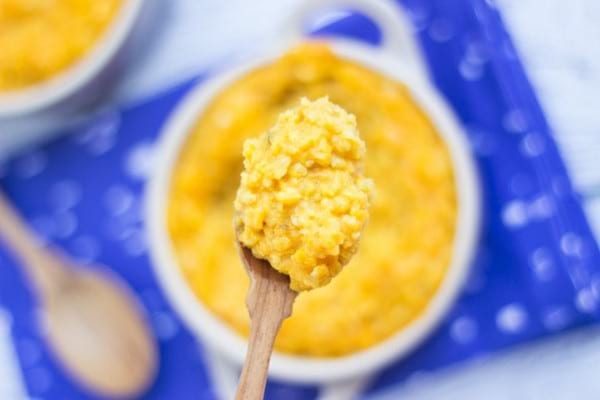
Okay, so there's no denying this is NOT mac and cheese.
There's no noodle, so yeah - it's missing out on that major ingredient.
However, creamy butternut squash, fluffy and light quinoa, and low-lactose goat's cheddar come together for a healthy trio that makes for a rich and lighter version of this comfort food classic.
It's worth a shot if you're looking to cut back on calories, dairy, or gluten!
10. Quinoa pizza bowls from Gimme Some Oven

Craving pizza but can't fit it into your healthy diet?
Meet your cravings in the middle with this ultra-satisfying single-serving pizza bowl.
These are so easy to make and really capture the essence of a good slice of 'za. It's less greasy, more cost-efficient, and higher in protein.
Indulge wisely with this super fun and kid-friendly recipe.
This article was fact checked for accuracy by Dr. Kim Langdon, MD. As always, this is not personal medical advice and we recommend that you talk with your doctor.
Share on Pinterest
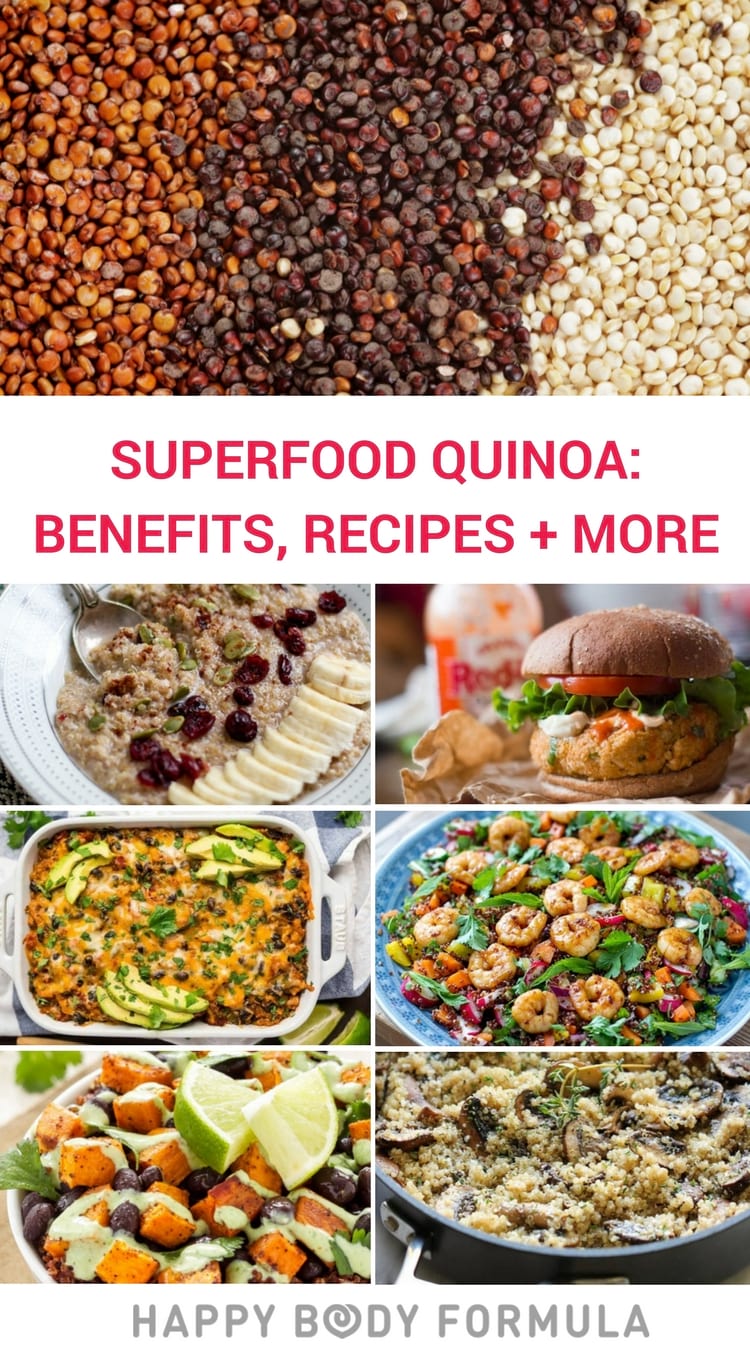
Kimberly Langdon M.D. is a retired University-trained obstetrician/gynecologist with 19-years of clinical experience. She delivered over 2000 babies to mothers in a suburban Midwestern community.
